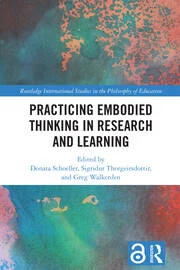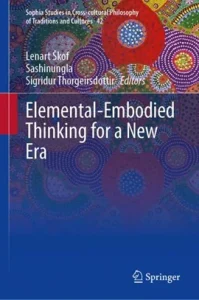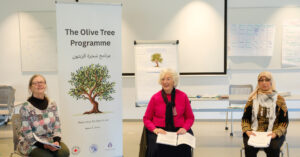This book delves into the embodied ground of thinking, illuminating the transition from theorising about the embodied mind to actively practising embodied thinking in research, teaching, and learning. The authors speak from immersing themselves in novel methods that engage the felt, experiential dimensions of cognition in inquiry.
The turn to embodiment has sparked the development of new methodologies within phenomenology, pragmatism, and cognitive science. Drawing on Eugene Gendlin’s philosophical work on felt understanding, and Francesco Varela’s enactivist approach, contributors explore innovative embodied thinking methods such as Focusing, Thinking at the Edge, micro-phenomenology, and mindfulness practices. They demonstrate the practical applications of these methods in research, teaching, and learning, highlighting their liberating and empowering potential for researchers and students. In an age marked by information overload and societal polarisation, methods of embodied thinking provide an innovative edge to critique, complementing more traditional approaches to critical thinking with listening skills and reflexive care.
This book shows how heeding the essential, yet often overlooked, embodied grounds of critical and creative thinking can deepen and strengthen each of research, teaching, and learning. It will interest philosophers of education and educators in higher education in particular, as well as researchers and postgraduate students from philosophy, and the cognitive and social sciences, who are curious about how embodied thinking can enrich research, teaching, and learning.
The Open Access version of this book, available at www.taylorfrancis.com, has been made available under a Creative Commons Attribution-Non Commercial-No Derivatives (CC-BY-NC-ND) 4.0 license.
Editors: Donata Schoeller, Sigridur Thorgeirsdottir and Greg Walkerden
This collection responds to widespread, complex, and current environmental challenges by presenting eleven original essays on a new elemental-embodied approach in environmental humanities. This approach has a special focus on elemental and indigenous philosophies as well as localized experiences of terrestrial forces: from earthquakes and eruptions to pandemics and natural disasters. Representing a shift in modern Western scientific and disembodied thinking of nature, this edited book approaches the question of relationality and intertwining of human and natural being by utilizing the elemental-embodied methodologies within philosophy of embodiment and nature. Supported by research in cognitive sciences, the contributors represent the experiential and affective turn within research into human cognition. As embodied, the human being is embedded and interacting with all there is. The aim of this edited volume is to indicate new paths toward regaining our access to natural being within us and thus toward reconnecting with the natural environment and the things and beings around us in a new, environmentally enhanced way. It appeals to researchers and students working in many fields, predominantly in philosophy, as well as religious and environmental studies.
Editors: Lenart Škof, Sashinungla and Sigridur Thorgeirsdottir
"The Olive Tree Program" with Ghada Radwan
The Olive Tree Program was held at the University of Iceland from May 30 to June 3. The Olive Tree Programme aims to train individuals in methods that enable them to develop resilience and emotional endurance. The instructors were Margaret Quinn, Tom Larkin, and Mary Jennings from the Irish Focusing Network. They have decades of experience in training and applying embodied-cognitive techniques such as focusing, which are rooted in a felt sense for issues and problems.The methodology of focusing was developed by Eugene Gendlin at the intersection of psychology and philosophy.
Learn more about the project by viewing our documentation or listening to the podcast.
"Beauty Landscape and Nature" with Gugga Jóhannesdóttir
In this episode Gugga discusses her interest in the concept of beauty and how it is often narrowed down to something superficial but she redefines beauty as something at the core of being human, an experience that allows us to sense our connection to the world. For Gugga the subtle everyday experiences of beauty can be profound, offering a glimpse of our deep connection to the world. We discussed the meaning of landscape as an interaction between the person and the land and how to be a tourist so that our relation to places is not superficial, taking selfies, but deeper and aesthetic.
Minisophy, with Katrin Olina and Sigríður Þorgeirsdóttir
Minisophy invites the designer experience the world in tune with the elements and the living – it is a design thinking method and a way to integrate the human with the environment. By challenging our relationship to the environment at the design level, Minisophy aims to initiate a creativity that is more adaptable, empathic, courageous and sustainable.
Website: Minisophy
"Focusing and Philosophy" with Donata Schoeller
This is a shorter episode of The Living Process where Donata and I outline some of our mutual interests and especially some of her philosophical insights into Gendlin’s work. She describes her experience of working with Gendlin on the translation of A Process Model and a little bit about the recent Gendlin Symposium which we both attended. Donata and I have laid out a series of topics that we think would be valuable to delve into more deeply and so we plan to offer a series of follow-up videos on these topics.
"THE WORLD WE ARE" with Donata Schoeller
This time we are picking up where we left our last conversation and talking about whether a person has an ‘inside’. Topics we cover include “what words do”, what is visible and invisible and how even the invisible can still be perceived. We touch on the interaction of symbols and body, the different spaces we live in, Gene’s Process Model, the meaning of gestures, how this all works in the act of felt sensing. Later in the conversation we discuss how felt sensing is a dance and a primary process of making meaning. The general question we are exploring is whether people are separate? Donata expresses this in the beautiful statement: “we are immersed in a common world net”. Near the end, Donata asks, “What makes this practice so beautiful?” Where does the sincerity and integrity come from? We conclude the episode by agreeing on our topic for the next conversation.
"What is thinking?" with Donata Schoeller
In this episode Donata introduces Embodied critical thinking, and what kind of challenges it involves. How to include more of our experiences into all that we are thinking. We learn positions, arguments, and texts, but it is harder to integrate what we are experiencing from our own living. We discuss how Focusing and TAE are revolutionary methods to enter into the experiential ground from which our thinking grows. We have access to more than just opinions: Bringing in our own lived instances of the topic helps people have their felt underbelly of their thinking. But that move is considered to be private, subjective, or therapeutic. The philosophical culture does not readily allow this feeling of thinking. How can philosophy open up to the felt experience without being accused of becoming therapy? How do we soften the boundaries between the disciplines of philosophy and psychotherapy? Perhaps our idea of what discourse and thinking are remains too narrow for humans? Maybe knowing how to think implies knowing how to heal. Donata names three competencies for this embodied critical thinking. We need a kind of reflective care and experiential listening rather than critical thinking to process our deep thinking.
Podcast by Greg Madison: The Living Process. Practices in Experience and Existence.
"What is a person?" with Donata Schoeller
In this episode, we address the misunderstanding of Focusing as merely a private and subjective practice. Donata offers an understanding of Focusing that is radically different from the old model of subjective/objective. This takes us towards our next topic of ‘inside/outside’ and whether the body can be thought of as having its own subjective ‘inside’ that is separate from the world. The episode is about 30 minutes and will, I think, be of relevance to anyone who focuses and how they understand their experience in fresh ways.
Podcast by Greg Madison: The Living Process. Practices in Experience and Existence.
"Focusing and Philosophy " with Donata Schoeller
This is a shorter episode of The Living Process where Donata and I outline some of our mutual interests and especially some of her philosophical insights into Gendlin’s work. She describes her experience of working with Gendlin on the translation of A Process Model and a little bit about the recent Gendlin Symposium which we both attended. Donata and I have laid out a series of topics that we think would be valuable to delve into more deeply and so we plan to offer a series of follow-up videos on these topics. Our hope is that offering a series of shorter videos rather than trying to pack too much into one episode, will help us to offer conversations that can act as outreach to people who are new to Focusing, Focusing Therapy, and Gendlin’s philosophy. Keep an eye out for these upcoming offerings…
Podcast by Greg Madison: The Living Process. Practices in Experience and Existence.
Mind and Life Europe Friends webinar: "Embodied Critical Thinking" with Donata Schoeller
In this exclusive MLE Friends webinar, Dr. Donata Schoeller (MLE Association Member) talks about her interdisciplinary research project on Embodied Critical Thinking, introduces the methods used and reflects on current struggles and questions.
Website: Mind and Life Europe
"3 Topics that Fascinate me about Focusing, recently" with Akira Ikemi
In this lecture, Professor Dr. Akira Ikemi (Kansai University) presents his innovative contributions to the field of Focusing. He will introduce the concepts of „Focusing-alpha“ and „Focusing-beta,“ as well as his theoretical framework known as „The Experiencing Model.“ Additionally, he will discuss his advancements in integrating Focusing with Mindfulness, which have culminated in the development of three unique practices collectively referred to as „Asian Focusing Methods.“
The lecture was held at the Psychology Auditorium of KU (Katholic University)- Leuven [Belgium], on September 18, 2024 — in the year celebrating the 600th anniversary of the university.
"Decolonizing Nature" with Sigríður Þorgeirsdóttir
ALKING OBJECTS LAB @Goethe Morph* Iceland. The three-day performative conference UNEXPECTED LESSONS #2 took place as part of the festival Goethe Morph* Iceland at Nordic House in Reykjavik on September 13th – 15th, 2022.
"Focusing, Vastness and Union" with Greg Walkerden
We will explore a variation to Focusing practice that carries it in the direction of mystical experience in ways that are resonant of what in the Christian tradition might be called “Resting in the Presence of God” and in Buddhism “Relaxing into Presence.”
The research the talk is based on is described more fully here: Walkerden, G. (2021). ‘Focusing, vastness and union: Elaborating the Focusing practice tradition and the Philosophy of the Implicit to describe an additional kind of space’, In N. Kypriotakis, J. Moore (eds.), Senses of Focusing v2, Eurasia Publications, Athens, p.127-147. FYI the Abstract and this chapter.
"Gendlin's Process Model - Internal Structures" with Satoko Tokumaru
A Process Model, Gendlin’s magnum opus, offers no less than a new alternative to the dualism of mind and body. Beginning with living process, the body’s simultaneous interaction and identity with its environment, Gendlin systematically derives nonreductive concepts that offer novel and rigorous ways to think from within lived precision. In this way terms such as body, environment, time, space, behavior, language, culture, situation, and more can be understood with both great force and great subtlety.
Podcast: The International Focusing Institute
"The Philosophy of the Child and philosophical thinking" with Sigríður Þorgeirsdóttir
IApH 2021
"Líkamleg gagnrýnin hugsun" with Guðbjörg R. Jóhannesdóttir
Lektor við listkennsludeild Listaháskóla Íslands og nýdoktor við Heimspekistofnun Háskóla Íslands
"Þögul þekking og ígrundun í kennaramenntun" with Kristín Valsdóttir
Deildarforseti við Listaháskóla Íslands
"Writing Collaboration" with Greg Walkerden
Three Developmental Layers Supporting Our Writing Projects
1. Conversational scaffolds (to support us listening to each other, and each of us listening to ourselves, and thinking creatively together and finding alignment)
2. Microprocess scaffolds 3. A task reference point The process is elaborated in a chart: Writing Collaboration Process ©Greg Walkerden 2024
Podcast: Help for Helpers
Trailer "Épochè" with Claire Petitmengin
The suspension of verbal and perceptive judgment, the suspension of conceptual superimpositions on lived experience, is the common ground of both phenomenology and meditative practice. But how does one suspend judgment? How does it feel? What kinds of understanding of ourselves and our relation to others and to the world may unfold through this particular operation?
In May 2019, 40 phenomenologists and meditators met near Loire valley to form a living laboratory. Their purpose was to investigate the experience of épochè; a central concept in phenomenology, often referred to as the act of suspending judgment.
This film documents how new understandings emerge in interactions between phenomenologists and experienced meditators. Through microphenomenological interviews and meditation they come to see the contours of specific micro-acts and micro-events that appear to be key to our ability of suspending judgment.
"We are each others environment - imagining a culture of Moments of Wonder" with Monika Lindner
What would a world be like that allows children to experience Moments of Wonder as
normality? Adults, as relevant interaction partners, form the social environment (#en3) of
children and have power as well as responsibility to shape it. This workshop follows the idea
that Thinking At the Edge is a practice that through self-reflection of one’s own attitude (as a
parent, as an educator, as an adult companion) can shape a cultural and social environment
that could establish the moment of change as Focusing facilitates it, as a cultural practice.
Participants will receive theoretical input and the opportunity for self-experience.













